FUNDY ISSUES #18
Spring 2001
Whither the Weather?Climate Change and the Bay of Fundy
"it is not just the rising temperature that we need to worry
about; global warming is likely to trigger
major changes in a wide range of meteorological and oceanographic processes worldwide.
"

Many old timers living around the Bay of Fundy are firmly convinced that the climate is changing. They vividly recall when they were "young’uns", struggling to school through more frequent and much deeper snowdrifts than today’s kids ever encounter. They recollect too that "winters were a whole lot longer and much colder way back then - in fact the harbour often froze solid, right across". But climatologists, the scientists who study our changing weather patterns, have a hard time grappling with such "anecdotal" stories. There aren’t any good, solid numbers that can be squeezed into the mathematical equations and models used to measure changes and make predictions. It’s much easier to work with the precise digits buried in the copious weather records collected at many places around the world for more than a century. Sometimes, the less direct, but nevertheless measurable and thus scientifically acceptable, record of climate kept by trees in their annual growth rings and glaciers in their icy layers can be used as "proxy" climate traces. After analysing such information, most climatologists now agree that climates are changing, although perhaps not quite as dramatically as some old timers would have us believe. A few scientists still question whether the changes are simply inevitable natural fluctuations that have been going on for aeons, or are a new and ominous consequence of activities of humans during the past century or two. However, the weight of evidence now strongly indicates that our activities are indeed altering the climate at a quickening pace that could unleash a lengthening catalogue of worrisome social, economic and ecological consequences. Thus, "climate change" quickly became one of the dominant environmental issues in the closing decades of the twentieth century - and the concern continues unabated into the new millennium. Weather, Climate and Global Warming
It is important to note the difference between weather and climate. Weather refers to short-term changes in atmospheric conditions, while climate deals with events happening over a much longer period. Climate reflects the average seasonal weather conditions in an area, while weather is the short term fluctuation about the average, or as Environment Canada succinctly puts it, "climate is what you expect - weather is what you get". Day to day weather measurements, such as temperature, hours of sunshine or precipitation are often well above or way below the expected "normal" conditions for a given date or time period. "Climate change" refers to gradual variations in the average weather conditions over a long time period and usually over much, if not all, of the Earth. Rising temperature, or "global warming", is just one aspect of the overall changing climate, but it is the one that has captured most of the scientific and public attention.
Long-term trends in climate are not easy to detect because of the normally wide swings from day to day, and the periodic occurrence of "record" extremes. There are also naturally occurring cycles in the climate of any region, related to variations in solar activity, shifts in ocean currents or a variety of other natural fluctuations. Some of these shifts may happen over a decade or so, others over periods far greater than the human life span. Thus, our memories of past weather conditions are not a reliable indicator of whether climate is getting progressively better or worse. Only by keeping detailed records of many aspects of the weather for long periods, and then analysing them with complex statistical methods can we determine if the climate is really changing in one direction or another. Even when we detect such changes, there still remains the nagging possibility that what we are seeing is just a part of a much longer natural climatic cycle. Perhaps we simply haven’t been keeping weather records long enough to be able to detect a cyclical pattern produced by some unrecognized natural process.
Complexities of Climate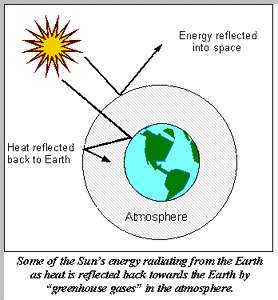
How much of the Sun’s vast energy output is reflected, absorbed and distributed over various parts of the Earth largely determines the nature of the climate in different places. It is much more complicated than the obvious fact that equatorial areas, more directly oriented towards the Sun, receive more energy and are warmer than polar regions that curve and tilt away from it. The energy absorbed or reflected back into space varies according to the mosaic of light and dark areas of the Earth’s surface. Lands darkened by vegetation absorb more solar energy than white reflective areas such as icecaps. When the Sun’s rays pass through the atmosphere and strike the surface, some of the shorter wavelength light energy is converted to heat energy. This heat energy radiates from the surface as longer wavelength "infrared" rays. These would normally pass through the atmosphere and out into space were it not for the presence of gases that trap and retain the heat energy. These naturally occurring, heat-trapping compounds include water vapour, carbon dioxide, methane and nitrous oxide. A similar heat-trapping process takes place inside greenhouses. The Sun’s light rays passes readily through the glass and warms things inside. However, the radiated infrared energy doesn’t pass through glass as easily, and much of it stays within the greenhouse. Not surprisingly, the comparable process happening in the atmosphere was called the "greenhouse effect" and the responsible gases nicknamed "greenhouse gases". It has been estimated that if these gases weren’t present, the average air temperature at the surface of the Earth would not be a relatively balmy 15°C, but a bone-chilling -18°C.
The differing amounts of solar energy received by different
areas of the globe influences the air temperature of those regions. Air is a very mobile
medium, and if some parts are warmed more than others, it starts to move. Warmer air,
being lighter, rises and cooler air then flows from surrounding areas to replace it. Areas
of low and high atmospheric pressure form in different regions and these channel the air
moving near them. These "pressure cells" tend to move in characteristic
directions during different seasons, carrying winds, air masses and weather events along
with them. Similar motions, called currents, are set up in the World’s oceans as a
result of regional differences in the prevailing wind, water temperature or density of the
water. The overall tendency of both the moving atmosphere and the flowing ocean is to
carry warmer tropical air and water towards the poles and colder polar air and water
towards the tropics, in a never ending effort to even out the energy differences between
the two regions. The ocean currents are particularly good at transporting heat energy,
since water can hold a thousand times more heat than air can. The major current systems in
the worlds oceans, such as the Gulf Stream, that carry excess heat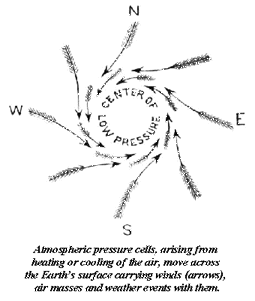 from
tropical regions towards the poles are part of what has been aptly called the "Global
Ocean Conveyer Belt". However, predicting the movements of air and seawater over any
distance is a difficult and complex process, given the infinite variety of twists and
swirls that can occur in three dimensions. Even using the best mathematical models and
most powerful computers available, oceanographers and meteorologists are still only able
to confidently predict water and air movements over relatively short distances and time
periods.
from
tropical regions towards the poles are part of what has been aptly called the "Global
Ocean Conveyer Belt". However, predicting the movements of air and seawater over any
distance is a difficult and complex process, given the infinite variety of twists and
swirls that can occur in three dimensions. Even using the best mathematical models and
most powerful computers available, oceanographers and meteorologists are still only able
to confidently predict water and air movements over relatively short distances and time
periods.
The climate of a region is also markedly influenced by many other factors. Its latitude, or distance north or south of the Equator, clearly plays a major role. No one could possibly confuse the climate of Iceland with that of Jamaica. Its altitude, or height above sea level, influences climate in ways similar to that of latitude. As you go up a mountain, the average temperature falls every hundred metres or so, comparable to moving hundreds of kilometres northward. Nearby mountain ranges and their orientation can also markedly influence climate. The dryness of western prairies is largely attributable to the presence of mountain ranges to their west. Where a place is located in relation to the prevailing atmospheric circulation patterns and principal ocean currents, such as the Labrador Current off Atlantic Canada, also influences the climate and weather. Nearby large bodies of water such as a lake or a sea can moderate seasonal fluctuations in temperature by absorbing heat from warmer air and releasing it to cooler air.
Tracing the TrendsThe global climate has been changing continuously throughout the billions of years of the Earth’s existence. There is a lengthening roster of naturally occurring "proxy" records of such climate fluctuations over the past several hundred thousand years - inscribed in the composition of rocks, layered in ice sheets or detailed in the distribution patterns of fossil remnants of plants and animals. These all clearly show the occurrence of dramatic variations in climate over long periods of time. "Ice ages", when large areas of the Earth were gripped by glaciers, seem to have happened about once every 100,000 years. Between these ice ages were periods when the Earth’s average temperature rose by 4-8°C, causing the icy masses to retreat towards the poles. Such long-term changes in climate are thought to have resulted from periodic shifts in the orbit of the Earth around the Sun, or in the energy output from the un. The last Great Ice Age ended about 11,000 years ago. At that time, the vegetation around the Bay of Fundy was probably like that of the present Arctic tundra, and herds of Mastodons roamed the landscape. During the 10th to the 14th century there was a "Medieval Warm Period", when the average temperature in the Northern Hemisphere reached its highest point in the past 4,000 years, which was only about 1°C higher than at present. Then, from the 16th to the 19th century there was a Llittle Ice Age", when the average temperature of the Northern Hemisphere was a degree or two cooler than now. It was not cold enough to cause the polar glaciers to expand much, but those in some mountainous regions did advance noticeably. Since then the average global temperature has been slowly rising, increasing by about 0.4-0.8°C over the last 100 years. Here in Canada it rose slightly more rapidly, by 1°C between 1895 and 1992. The 20th century has been the warmest one since medieval times. The 1980s and 1990s were the warmest decades in the past 150 years, and 1997 and 1998 were the hottest years on record. In the past century the Earth has warmed more rapidly than at any time since the end of the last great ice age. Clearly the Earth is warming.
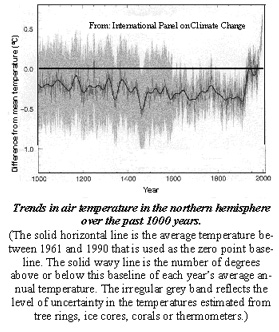
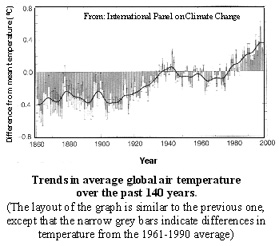
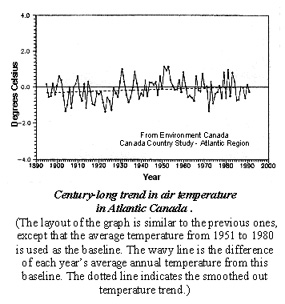
Catalysts of Change
The question is whether this accelerating rise in temperature is a natural
phenomenon or an unforeseen result of increasing human population and industrial
development. If it reflects a natural cycle, then there is probably not much that we can
do about it except monitor it and make whatever adjustments are necessary in a timely
manner. However, if our activities are largely to blame, then we might be able to change
the way we do things and slow the temperature rise. But how could we humans be influencing
global climate? There is a growing body of evidence that the quantity of greenhouse gases
in the atmosphere has been rising steadily over the last century. The majority of
scientists are now convinced that this is exacerbating the "greenhouse effect"
by trapping ever more of the suns’s energy and thereby raising the temperature
worldwide. Carbon dioxide is the principal culprit and may account for as much as three
quarters of this energy trapping. 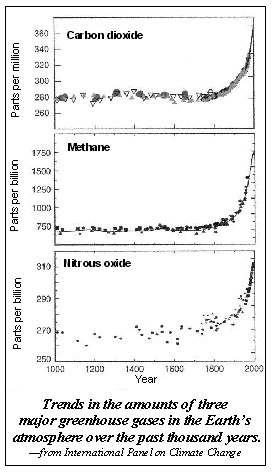
For hundreds of thousands of years the amount of carbon dioxide in the atmosphere seems to have been fairly constant. Most of what was released by natural processes was balanced by the amounts taken up by plants or absorbed by the oceans. However, over the past couple of centuries humans seem to have upset this delicate balance, causing carbon dioxide levels to soar. The clearing of vast tracts of forest worldwide for agriculture, ranching and timber has seriously impaired these once great absorbers of carbon dioxide, or "sinks". In addition, clearing the land and burning the trees prematurely released huge amounts of the stored carbon back into the atmosphere. This is blamed for 15 - 20% of the current rise in the production of carbon dioxide. The remaining 80 - 85% of the carbon dioxide emissions come from the burning of fossil fuels, such as coal, oil and natural gas. These fuels are drawn from vast reserves of energy rich carbon compounds that were synthesised, accumulated and trapped underground over unimaginably long spans of geological time, millions of yeas ago. In the 200 years since the start of the industrial revolution, we have plundered these subterranean energy storehouses, burned their contents to sustain our energy-hungry industrialised society and released huge amounts of additional carbon dioxide into the atmosphere. The rate at which we are doing this has been steadily rising. It is now estimated that human activities are releasing 28 billion tonnes of carbon dioxide into the atmosphere every year. British scientists have used microscopic fossilised shells that accumulated over aeons in the mud of the deep ocean floor as an indirect or "proxy" indicator of carbon dioxide levels in seawater and the overlying atmosphere. By drilling a long sediment core they have obtained a continuous record stretching back million of years. This shows that carbon dioxide levels are now the highest they have ever been for at least 20 million years.
Unless we sharply reduce carbon dioxide emissions, and thereby dampen down the greenhouse effect, many scientists anticipate that global warming will continue to accelerate. By the end of this century the Earth could be up to 2°C warmer, while Canada’s temperature could rise by as much as 4°C, since the warming will be more pronounced in polar and temperate latitudes. However, it is not just the rising temperature that we have to worry about; global warming is likely to trigger major changes in a wide range of meteorological and oceanographic processes worldwide. Researchers know that it doesn’t take many degrees change in average temperature to have profound effects on the climate, weather, landscapes, oceans and ecosystems. Coastal areas, such as the Bay of Fundy, are particularly vulnerable to changes in climate, because it is there that the atmosphere and the ocean join forces to assault the land particularly aggressively on occasion.
Fundy’s FisheriesIf the climate in the Fundy region does change markedly, it will have profound effects not only on our terrestrial and aquatic environments but on our society’s whole economic foundation and way of life. Many of the most worrisome effects on forestry, agriculture, water resources, aquatic life, transportation, municipal infrastructure, recreation and tourism are described in the reports of the Canada Country Study, published by Environment Canada. Here, we can only consider the possible effects on Fundy’s marine ecosystem and those who dwell near it or depend upon it. For centuries, communities around the Bay have relied heavily on the fisheries. The harvest of living marine resources is still a vital industry in the region. It is not surprising, therefore, that there is great concern that climate change might adversely affect marine ecosystems. At present, not much can be predicted with any confidence, because there is still a lot that we don’t know about the way marine animals and plants respond to progressive changes in their environment. However, what little we do know suggests that there are going to be undesirable effects on many species.
Oceanographer Ken Drinkwater, of the Bedford Institute of Oceanography, notes that water "temperature is one of the primary factors …. in determining the large-scale distribution pattern of fish and shellfish." Long-term changes in average water temperature may cause an organism’s distribution range to shrink or expand, depending on the species’ temperature tolerance and preference. This is particularly true for populations in the southern or northern parts of their distribution range that may already be living close to their upper or lower temperature limits. For instance, when water temperatures south of Newfoundland fell slightly in the 1960s, a cold water fish, the Capelin, moved south as far as the Bay of Fundy. Then, in the 1970s, as the ocean warmed again, they shifted back to the north. Other species such as cod, halibut and plaice also altered their distributions in a similar fashion. Many of our commercially valuable groundfish species are near the southern edge of their range in the waters of the Bay of Fundy and Gulf of Maine. Thus, if the sea warmed only a degree or so, it is likely that some of them would withdraw towards the north. However, some warmer water species now living to the south would probably extend their ranges northward into the Fundy region. Changing ocean temperatures might also cause some fish to alter their migration routes, departure and arrival times, or their final destinations.
Temperature not only influences the distribution and movements
of fish, but also subtly affects many important biological processes, such as the number
of eggs laid, incubation time, survival of the young, growth rate, feeding rate, time it
takes to reach maturity and a host of other physiological processes. For example, cod grow
faster in warmer water. A four-year-old fish living on Georges Bank in the Gulf of Maine
is almost five times larger than one of the same age living in colder Newfoundland waters.
Furthermore, cod mature in seven years off Labrador, in six years off eastern Nova Scotia,
in three and a half years off southwest Nova Scotia and in only two years on Georges Bank.
However, further warming of the Gulf of Maine probably wouldn’t make the fish grow
any faster, they’d simply move northward into cooler waters. 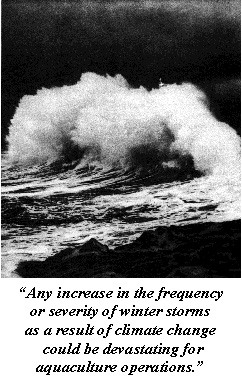
The complex and interconnected biological processes of egg laying, hatching, feeding, growing and maturing all play a role in determining "recruitment", the measure of fish production that is of greatest interest to fishermen and fisheries managers. This is simply an estimate of the number of animals that survive and eventually get large enough to "enter the fishery" or be legally harvestable. Ken Drinkwater notes that "recruitment levels have frequently been associated with variations in temperature during the first years of life of the fish". He points out, for example, that in Newfoundland waters, recruitment of cod is usually high when the water is warmer and declines as it cools. However, there are so many complex variables that influence recruitment that no one can predict with any certainty how ocean warming would affect recruitment of the fish stocks in the Bay of Fundy. We also know little about the consequences for fish stocks of alterations in currents and water mixing that would undoubtedly accompany changing ocean temperatures. Currents disperse the floating eggs and larvae of many species, and any shifts could carry them into areas where conditions are less suitable for survival and growth. Neither do we know how changing water temperature will affect the abundance of the prey species that cod and other fish depend on, or to what extent it might influence the populations of their predators, such as seals, porpoises and seabirds. Trying to predict what effect changes in climate will have on the fish and other species in the Bay of Fundy is, in the words of Ken Drinkwater, "a highly speculative exercise".
The impact of climate change on salmon and shellfish aquaculture in the Bay is equally difficult to predict, but it is likely that there could be both beneficial and detrimental consequences. Warming of coastal waters would make the salmon grow faster during the summer. It might also reduce the costly fish kills that occasionally happen when the water temperature falls too low in the winter. However, such benefits might be more than offset by increased incidence of toxic blooms, disease or parasites. Significant changes in the average temperature of coastal waters might also alter the types of fish and shellfish that can be successfully farmed in the region. Alterations in water mixing or current patterns caused by climate change might also alter the rates of water exchange, or flushing, in coastal embayments. Productive aquaculture sites need good water flow to remove solid and dissolved wastes and maintain high oxygen levels in the cages. Any increase in the frequency or severity of winter storms as a result of climate change could be devastating for aquaculture operations. Periodic gales already occasionally tear apart floating cages, freeing the farmed fish to mix with wild populations. However, more research is urgently needed before the likelihood and consequences of any of these meteorological and biological effects can be ascertained.
Climate Change and Marine WildlifeThe distribution ranges of many other marine species, such as whales, seals, waterfowl, shorebirds and seabirds, are also largely determined by air and water temperatures. If climatic conditions in the Bay of Fundy change significantly, it is probable that the types of wildlife living there will also change. Certain species would probably move out of the area, while others would almost certainly move in to take their place. Changes in the distribution and abundance of zooplankton or fish might also force the marine mammals and seabirds that eat them to move elsewhere.
Ocean warming and sea level rise may reduce the upwelling and mixing processes that make the mouth of the Bay so highly productive. This could be disastrous for the sea birds and marine mammals that congregate there to feed and reproduce. It might also be yet another stress on the North Atlantic Right Whales that use the outer Bay as a nursery area. Even now, during the occasional summer when oceanographic conditions in the Bay vary slightly from the norm, it appears that the Right Whales tend to go elsewhere in search of food. Rising sea level and an increase in the frequency and severity of winter storms could also further erode the salt marshes and mudflats that are critical staging and feeding areas for many species of migrating shorebirds and waterfowl. Changing weather patterns, particularly during the spring breeding season, could have devastating consequences for the reproduction of waterfowl and other birds that regularly nest in the region. Ultimately, it is likely that very resilient species, such as herring gulls and grey seals, will tolerate the climate change and increase in numbers, while more specialised species, such as sandpipers and porpoises, would be forced out. In addition, southern species would probably move into the area. The final result could be a "scrambling of animal and plant communities", rather than a simple shift of the existing communities northward with rising temperature.
The Rising SeaA large rise in sea level, as a result of climate change, could pose a serious threat to many coastal communities in the Maritimes. Some 36,000 years ago, the last major ice age slowly spread its icy fingers over northern and southern regions of the globe. The falling temperature, prolonged winter snowfall and reduced summer melting allowed the snow to accumulate over the years. This thickening snowpack eventually compressed itself into kilometres-thick ice sheets that covered much of North America and other areas of the globe. The huge amounts of ice forming these glaciers consisted largely of water drawn from the world’s oceans. As a result, the sea level worldwide fell by as much as 100 metres, the height of a 24-story building. With the end of the ice age, the process reversed and sea level has been creeping upwards again as a result of the release of water from melting icecaps and a slow subsidence of the land in some areas. In addition, as the seawater warms its volume increases. It is estimated that over half the current sea level rise is due to such thermal expansion of the ocean. Thus far, this rise has been a slow process, barely perceptible in the course of a human lifetime. Over the past century, it has risen about 10-15 centimetres worldwide. In the Bay of Fundy, the rise has been even greater, about 40 centimetres in a 100 years, largely because the land has been simultaneously subsiding about 30 centimetres.
The changes in sea level thus reflect the long, slow natural fluctuations in climate that have been happening for millions of years. However, there is concern that the recent, very rapid global warming is melting the glacial ice faster than ever before. A rapidly rising sea level increases the likelihood of massive flooding in coastal areas. Ironically, in the last few centuries human settlements have tended to cluster mostly along coastlines. In the Bay of Fundy, a gently sloping shore means that even a slight rise in sea level exposes disproportionately large areas to the risk of flooding. Lands protected by dykes are particularly vulnerable, because they are already well below sea level. The average sea level in the Bay has risen about 1.3 metres since the Acadians first built their dykes here in the 1630s. The rising sea will eventually top the dykes unless they are continually raised and repaired, a mammoth and expensive undertaking. Higher sea levels will also cause increased coastal erosion, particularly in the upper Bay where the vigorous tidal currents and waves are already rapidly eating away the soft sandstone and shale shoreline. It is also likely that the characteristic fringing salt marshes and mudflats will creep slowly inland as the water steadily rises. However, coastal roads and other shoreline structures may interfere with the natural movement of salt marshes landward. Given the uncertainty about the many environmental changes that will accompany a rising sea level, it is almost impossible to predict the overall effects on shorelines and ecosystems.
Weather Worries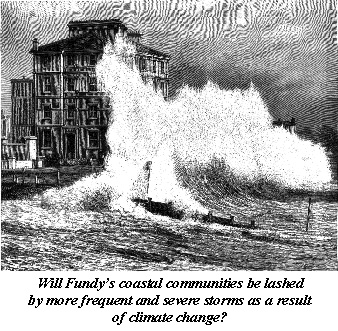
Maritimers are no strangers to so-called "extreme weather events". Fortunately, these are relatively infrequent hereabouts. But some climatologists warn that climate change is going to make such weather extremes more frequent and possibly even more intense. The exact consequences are hard to predict, but one might anticipate such things as increasing storm damage, severe droughts and crop failures, and more frequent school closings in winter. The list of possible disruptive effects on our surroundings and daily activities is almost endless. A January 2000 storm that moved 15 tonne boulders and damaged wharves along the Nova Scotia coast of the Bay of Fundy may be a harbinger of things to come. Those who work or depend on the sea are understandably worried by the possibility of an increase in the ferocity of marine weather. However, they can take some solace from the fact that not all scientists agree that severe weather is on the rise. Weather records collected b the US National Oceanographic and Atmospheric Administration (NOAA) show no change in the frequency of storms over the 50 years prior to 1995, and no significant increase in the strength of the largest hurricanes seen each year. However, as with mutual funds, past performance is no guarantee of things to come. The Surging Sea
People in coastal communities around the Bay of Fundy have always been acutely aware of the awesome power of the sea when it is whipped into a fury by winter gales. Every year several major storms, including a few hurricanes, thunder up the curving eastern seaboard along a well-worn track that brings them right over the Maritimes. The location of the Bay of Fundy near the tail end of this "hurricane alley", coupled with its extremely high tides and low shorelines in many areas, makes the region particularly vulnerable to storm damage. People living in coastal communities have to contend with a much more insidious and potentially lethal threat than just high winds and precipitation. As it roars over the open expanses of the Gulf of Maine, the wind, in conjunction with low atmospheric pressure that raises the local sea level, pushes a growing bulge of seawater ahead of it. As this watery mound, or "storm surge", advances on a gently sloping shore it rises even higher. It may reach several metres above the normal high tide level and inundate areas normally untouched by the sea. Such a surge may flood coastal areas many hours before the storm itself arrives, catching residents off guard and quite unprepared.
By chance, most such storm surges arrive on our coast when the tide is partially or fully out, and thus their watery reach is largely confined to the intertidal zone. The
More and more people are beginning to take this threat of storm surges seriously. A number of coastal communities have already embarked on detailed terrain mapping projects to predict the areas that would be flooded by storm surges of different heights. With Geographic Information System (GIS) software, accurate terrain data and a computer, it is now possible to "virtually flood" digital maps of an area with a surge of any size desired, at any stage of the tide. This modelling exercise can quickly highlight any problems likely to crop up in a real flood. A community group, the Clean Annapolis River Project (CARP), recently carried out such a study in the town of Annapolis Royal and vicinity. It quickly became apparent that a large storm surge would flood the land all around the town’s fire department, effectively isolating it on a small island. This is not a particularly comforting thought for citizens faced with an emergency. More detailed mapping of land elevation is required to properly assess all the potential impacts, because in such flat coastal landscapes differences of only a few centimetres can greatly influence the extent of flooding. Such mapping exercises are also helpful in showing where floodwater might be trapped behind dykes, thus prolonging the flooding. All of the potentially vulnerable coastal communities around the Bay of Fundy need to be similarly mapped and assessed. Given that tidal surges could conceivably reach several metres, and that most of the coastal population lives within a few metres of sea level, the potential scale of the problem is obvious. Only by extensive and accurate simulation modelling can we prepare ourselves and try to avert the worst ravages of storm surges.
Coping and CurbingScientists wrestling with the problem of greenhouse gases and climate change warn that there may be little that we can do to halt the temperature rise over the next century or so. The vast amounts of carbon dioxide already released are already insidiously at work trapping more and more solar energy, and will continue to do so into the foreseeable future. However, for both ecosystems and humans it is not just the change in climate itself that is really the problem. As we have seen, there has always been climatic change, but usually at a pace slow enough for animal populations, ecosystems and human societies to adjust gradually to the shifting conditions. The worry about the present predicted round of climate change is that it is happening too quickly, and there may be little time to prepare and adapt. The best that we might be able to do is to reduce the accelerating rate of warming somewhat by cutting back on our wasteful use of fossil fuels. This might at least buy us more time to learn more about the likely impacts of the coming environmental changes and perhaps work out ways to adapt to them and avoid some of the worst effects.
Both industrialised and developing countries will have to participate in efforts to reduce the emissions of carbon dioxide and other greenhouse gases. The first important step in this direction was taken at the Earth Summit in 1992 with the signing of the "Framework Convention on Climate Change". At a subsequent meeting in 1997 in Kyoto, Japan, Canada and 161 other countries agreed to the "Kyoto Protocol". This agreement called for participating nations to collectively cut greenhouse gas production by 5.2 percent from the 1990 levels by the years 2008-2012. This clearly has important economic and social implications and the process is bogged down in debate over how to achieve this target without unduly weakening national economies. The recent intransigence of the United States, the largest producer of greenhouse gases, threatens the success of this international initiative. Other international bodies, such as the Intergovernmental Panel on Climate Change (IPPC), sponsored by the United Nations Environment Program, have been formed to review the scientific studies of climate change, identify the likely environmental and social consequences and suggest ways of avoiding or minimising the effects. A national group of 50 experts is playing a similar role in Canada as part of an ongoing "Canada Country Study" sponsored by Environment Canada. Regional "Public Education and Outreach Hubs for Climate Change Information" are also being set up in selected centres across the country to address the issues at the most local level. We as individuals must also do our part to reduce greenhouse gas emissions. Each time we use our car unnecessarily, heat our home inefficiently or use fossil-fuel generated electricity, we are releasing more of the fumes that are insidiously changing our climate. As the overview for the Canada Country Study bluntly concludes: "doing nothing until the last minute, then trusting to luck and hoping for some good weather is not an option".
Further Reading
John Belbin and De Clyburn. Clean Annapolis River Project. (December 1998).Tidal Surge Project. The Coastal Flooding Component of the Annapolis Climate Change Outreach Program.
The Canada Country Study: Climate Impacts and Adaptation, Highlights for Canadians.
Environment Canada, Ottawa, Ontario. 14 pages. (1997).Climate Change and Climate Variability in Atlantic Canada.
Volume IV of the Canada Country Study: Climate Impacts and Adaptations. Edited by Jim Abraham, Teresa Canavan and Roderick Shaw. Atmospheric Science Division, Environment Canada, Atlantic Region, Bedford, Nova Scotia. 131 pages. (1997).Predicted Response of Northwest Atlantic Invertebrate and Fish Stocks to CO2-induced Climate Change.
K.T. Frank, R.I. Perry and K.F. Drinkwater. Transactions of the American Fisheries Society, Volume 119, pages 353 to 365. (1990).Oceanic Changes Associated with Global Increases in Atmospheric Carbon Dioxide: A Preliminary Report for the Atlantic Coast of Canada.
D.G. Wright, R.M. Hendry, J.W. Loder and F.W. Dobson. Canadian Technical Report of Fisheries and Aquatic Sciences, Number 1426. 78 pages. (1986).Report of Working Group I. A Summary for Policy Makers.
Intergovernmental Panel on Climate Change. 20 pages. (January 2001).Climate Change Websites
Global Climate Change. Geological Survey of Canada, Website: http://agc.bio.ns.ca/science/clim/index.htmlThe Science of Climate Change. Environment Canada:
http://www.msc.ec.gc.ca/cd/climate/index_e.cfm
Government of Canada Climate Change Website: http://climatechange.gc.ca/english/index.html
Intergovernmental Panel on Climate Change Website: http://www.ipcc.ch/
The Canada Country Study. Climate Impacts and Adaptation: http://www.ec.gc.ca/climate/ccs/ccs_e.htm
Global Warming. The Union of Concerned Scientists Website: http://www.ucsusa.org/environment/0warming.html
A Beginner's Guide to the UN Framework Convention: http://www.unep.ch/iuc/submenu/begin/beginner.htm
This fact sheet may be reproduced and circulated, with credit to the
Bay of Fundy Ecosystem Partnership The Fundy Issues series is financially supported by:
The Environmental Conservation Branch
Environment Canada - Atlantic Region
Dartmouth, Nova Scotia
and
Department of Fisheries and Oceans
Scotia-Fundy Region
The views expressed herein are not necessarily those of the supporting agencies.
Written and produced by
J.A. Percy,
Sea Pen Communications
Granville Ferry. N.S.
e-mail: bofep@auracom.com